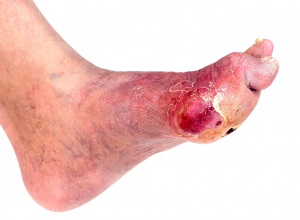
Diabetic Foot
Diabetic foot is an all-encompassing term for foot infections, ulcers and other issues diabetic patients experience due to their disease. Diabetic foot syndrome is a complex medical issue, because several factors contribute to it forming.
What Is Diabetic Foot?
A person’s foot is said to be a diabetic foot if it exhibits infection, diabetic ulcers, or neuropathic osteoarthropathy resulting directly from diabetes mellitus. A diabetic foot may exhibit one or even all of the above characteristics.
How Does Diabetic Foot Form?
Diabetic foot is a common complication that comes along with diabetes. Diabetes patients often experience peripheral nerve damage that leads to a loss of feeling and sensation in the legs and feet. This means that small sores, cuts, blisters, bruises, calluses, burns, diabetic ulcers and other skin irritation often go unnoticed for a long period of time. When these problems are left untreated, they can quickly become infected. However, this is usually just the beginning of diabetic foot.
About half of all diabetes patients develop peripheral artery disease (PAD), which decreases blood circulation to the extremities. When a diabetic patient’s body can’t pump enough blood to the site of an infection or a foot wound, the body cannot heal the wound. Over time, the infected area can begin to rot, and amputation may become necessary. In fact, foot infection is the most common cause of amputation in the diabetic community.
Another serious complication that can arise from diabetic foot is Charcot foot, a condition that results when a diabetic person suffering from nerve damage simultaneously experiences a softening of the bones and joints in their feet that leads to bone fractures and joint dislocation. Unable to feel the injuries, the affected patient continues to walk on the fractured and dislocated bones, which eventually leads to collapse of the foot and deformation. In many cases, the deformation leaves the patient with a permanent disability, and when PAD is present, Charcot foot often ends in amputation.
READ MORE: Dangerous Diabetes Foot Condition Puzzling Doctors
How Can Diabetic Foot Be Prevented?
According to medical specialists, one of the most unfortunate things about diabetic foot syndrome is that over half of all cases of the disease can be prevented. The key to stopping it from forming is to catch all injuries, wounds, ulcers, sores and infections very early in their development or, better yet, avoid them altogether.
In order to prevent diabetic foot, patients should give themselves foot inspections every day to check for changes or unusual symptoms like redness and swelling. It’s important to get even the smallest changes or symptoms checked, because even something like a patch of dry skin can leave the skin vulnerable to developing an infection that could lead to diabetic foot.
In addition to daily self-checks, diabetes patients should have their feet checked by a podiatrist at least once a year for a professional foot screening. This should be bumped up to several times per year if a patient is known to be at a high risk for developing diabetic foot ulcers.
RELATED: Simple Steps To Avoid Diabetic Foot Problems
Diabetes patients should wear soft, comfortable shoes that don’t rub or cause calluses and blisters. They should also do their best to regulate glucose levels, which can cut down the risk of developing nerve damage and PAD. Patients can also consider wearing temperature-monitoring socks or other devices that alert the wearer when inflammation or infection is in its early stages.
Meanwhile, it’s a good idea to see a multidisciplinary foot disease team if you do develop a wound or infection. Peter Lazzarini, senior research fellow at Queensland University of Technology, a PhD candidate and co-chair of Diabetic Foot Australia, says multidisciplinary foot care can prevent about half of all hospitalizations and amputations that arise from diabetic foot.
How Is Diabetic Foot Treated?
Because it is a complex condition with the body unable to heal itself, diabetic foot can be extremely difficult to treat and the treatment process is often prolonged.
Diabetic foot is often approached from several angles, including the use of antibiotics, topical dressings and orthopedic devices. However, amputation is common due to patients’ poor blood circulation and incessant infection that is increasingly resistant to antibiotics.
Notice concerning medical entries:
Articles having medical content shall serve exclusively for the purpose of general information. Such articles are not suitable for any (self-) diagnosis and treatment of individual illnesses and medical indications. In particular, they cannot substitute for the examination, advice, or treatment by a licensed physician or pharmacist. No replies to any individual questions shall be effected through the articles.






